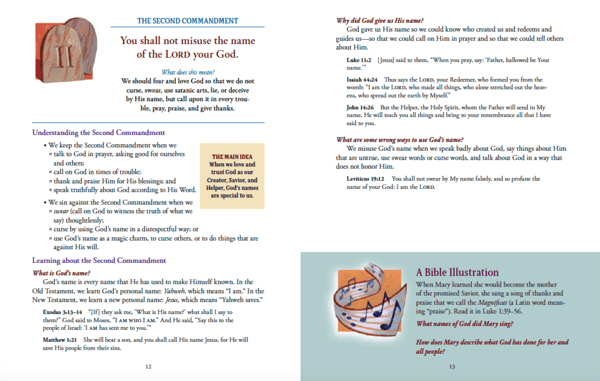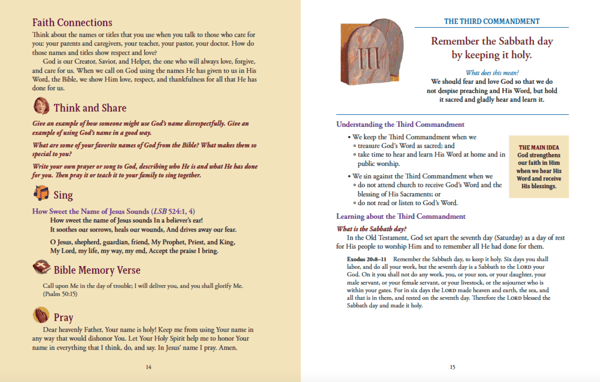One of my favorite things about homeschooling is the opportunity to be intentional about catechesis. I was homeschooled as a kid, and am now going through my second homeschooling journey, this time as the mom. I’m on my fourth year of “serious” homeschooling: this year we have a third-grader, a first-grader, a preschooler, and a one-year-old climbing around and keeping things interesting. Since the beginning, we have developed a rhythm of starting each school morning with devotions and catechism time.
This summer, as I was considering resources for the upcoming year I heard about the new Luther’s Small Catechism for Kids. I ordered it right away and was absolutely delighted to see that it is perfect! All the work had been done for me, and we will be covering exactly what I was hoping to cover.
A Catechism Routine at Home
For my fellow homeschooling families, this is a walk-through of how I’m using this new catechism with my kids this school year, but I believe that this approach could easily be tailored for use by any family, regardless of where your kids go to school or their ages. I spend around ten minutes per day on this, but it could be done even quicker or spread out to include more discussion if desired.
(A disclaimer: this is the plan that I follow, but please don’t imagine my children sitting angelically in a circle enjoying every second of this devotional time and participating perfectly. Our mornings are very “real life,” with attitude, reluctance, and distraction regularly present! Still, devotions are important for Christians of all ages, even—or especially—if they don’t look “picture perfect” all the time.)
Start with Music and Prayer
We start out with a prayer and a hymn. I have been using My First Hymnal with my kids for years. There are prayers, psalms, and short liturgies included in it that we have used at times. It is so beautiful and encouraging to see how many hymns my kids have memorized at this point. (Familiarity with hymns helps them be excited to participate in church on Sunday, even before they can read the words themselves!) We choose one hymn for the week and sing it each day. I usually select a hymn that correlates with the current season of the Church Year. If we have a baptism birthday in the family that week, we might choose a baptism hymn, etc. This new catechism resource provides a related hymn for each section, which I plan to draw from.
Using the New Children's Catechism
After our hymn, I open Luther’s Small Catechism for Kids and turn to the part for the week. Each of the six chief parts is broken down into its components, and each component (each commandment, each petition of the Lord’s Prayer, etc.) is given a three-page spread of devotional content. It starts with the text of the catechism itself (the part we memorize), followed by questions, answers, and relevant Scripture passages; a “Bible Illustration” section with a longer Scripture passage to study and discussion questions; a “Faith Connections” section that helps kids apply this part to their daily lives; some additional discussion questions, a hymn verse; a Bible memory verse; and a prayer.
We may not do everything, as my kids are young and their attention spans are limited, but there is enough great content here to use with kids who are in first grade or so through middle school. There are thirty-six sections! Perfect for a school year. Just simplify it for the younger kids and allow the older kids to look up all the Scripture passages and discuss for more content. For the youngest kids, My First Catechism can also be a perfect starting point.
Lesson Planning Sample
Below is a sample week focusing on The Second Commandment. Our daily routine goes like this: prayer, hymn, memory work, and discussion with further study. This shows how I broke up the devotional content into four days of discussion to accompany the memory work.- Monday – Work on memorizing the Second Commandment and explanation (I give each kid a few turns to try saying it, and prompt or assist as needed). Discuss the points and questions on the rest of p. 12.
- Tuesday – Repeat work on memorizing the Second Commandment. Discuss questions and Scripture passages on p. 13.
- Wednesday – Continue working on memorizing the commandment and explanation. Look up Luke 1:39-56 and do “A Bible Illustration” discussion questions, as provided on p. 13.
- Thursday – Continue memory work. Read “Faith Connections” and do the “Think and Share” sections. Discuss the verse of the hymn provided and how it relates to the second commandment. Read the “Bible Memory Verse.” (In future years, I may use this for memory work for my kids who have already memorized the catechism). Use the closing prayer.
- Friday – Our Fridays are structured differently, as this is my husband’s day off work. We usually have a sit-down “fancy breakfast.” This provides a great opportunity for the kids to share their memory work for the week with their dad.
Obviously, this is just what is working for us! Each family is different and will structure their devotional time differently. Honestly, every year I have to tweak and adjust my routine as my kids’ ages and dynamics change as our family grows. Something like this would work for families who do traditional schooling as well. You only need ten minutes in the morning to add this into your routine! It could be done over breakfast, or in the car on the way to school, or in the afternoon or evening.
For those who may be wondering, we do Bible readings each evening as part of our kids’ bedtime routine, so I don’t include biblical literacy in our homeschool time. But if that is something you want to add in, some of our favorite Bibles for our kids at different ages have been My First Bible Storybook, The Story Bible, and for our oldest who can now read on her own, The Growing in Faith Bible.
Get Luther's Small Catechism for Kids!

















